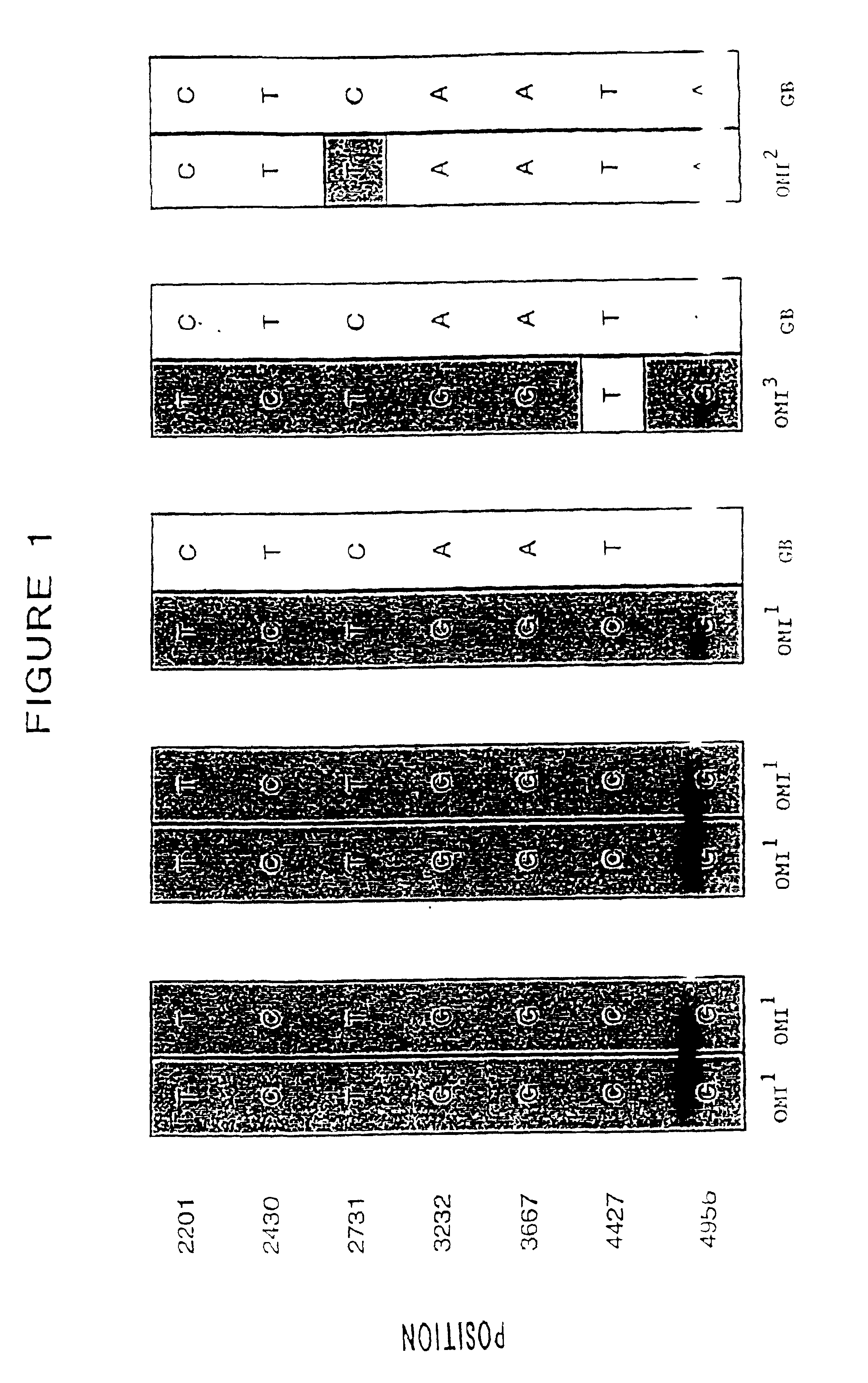Method for determining the haplotype of a human BRCA1 gene
a human brca1 and haplotype technology, applied in the field of human brca1 haplotype determination, can solve the problems of reducing the likelihood of misinterpreting a sequence variation, high risk of developing, and increasing so as to reduce the likelihood, increase the risk of contracting the disease sufficiently, and be easily identified or differentiated from polymorphisms.
- Summary
- Abstract
- Description
- Claims
- Application Information
AI Technical Summary
Benefits of technology
Problems solved by technology
Method used
Image
Examples
example 1
Determining the Functional Allele Profile for MSH2
[0121]Approximately 150 volunteers are screened in order to identify individuals with no cancer history in their immediate family (i.e. first and second degree relatives). Each person is asked to fill out the hereditary cancer prescreening questionnaire shown in Table 1, above. A first degree relative is a parent, sibling, or offspring. A second degree relative is an aunt, uncle, grandparent, grandchild, niece, nephew, or half-sibling. Among those individuals who answered “no” to all questions, five individuals are randomly chosen for end-to-end sequencing of their MSH2 gene.
[0122]Genomic DNA (100 nanograms) is extracted from white blood cells of five individuals designated as low risk of being carriers of mutations in the MSH2 gene from analysis of their answers to the questionnaire set forth in Table 1 above. The MSH2 coding region in each of the five samples is sequenced end-to-end by amplifying each exon individually. Each sample...
example 2
Determining the Functional Allele Profile for MLH1
[0133]All procedures (e.g., selection of five individuals at low risk of being carriers for MLH1 mutations, isolation of genomic DNA, amplification of exons, sequencing of amplified exons, and analysis of sequence data) are carried out as described in Example 1, above, except that the amplification is carried out using primers specific to the MLH1 exons as set forth in Table 4, below.
[0134]
TABLE 4MLH1 PRIMER SEQUENCESEx-onPrimerSequence1MLHAF5′-AGG CAC TGA GGT GAT TGG C-3′(SEQ ID NO: 35)MLHAR5′-TCG TAG CCC TTA AGT GAG C-3′(SEQ ID NO: 36)2MLHBF-2 5′-TGA GGC ACT ATT GTT TGT ATT T-3′(SEQ ID NO: 37)MLHBR-2 5′-TGT TGG TGT TGA ATT TTT CAG T-3′(SEQ ID NO: 38)3MLHCF5′-AGA GAT TTG GAA AAT GAG TAA C-3′(SEQ ID NO: 39)MLHCR5′-ACA ATG TCA TCA CAG GAG G-3′(SEQ ID NO: 40)4MLHDF-15′-TGA GGT GAG AGT GGG TGA-3′(SEQ ID NO: 41)MLHGR 5′-GAT TAC TCT GAG ACC TAG GC-3′(SEQ ID NO: 42)5MLHEF 5′-GAT TTT GTG TTT TCC CCT TGG G-3′(SEQ ID NO: 43)MLHER 5′-CAA ACA ...
example 3
Determining the Functional Allele Profile for BRCA1
[0140]All procedures (e.g., selection of five individuals at low risk of being carriers for BRCA1 mutations, isolation of genomic DNA, amplification of exons, and sequencing of amplified exons, and analysis of sequence data) are carried out as described in Example 1, above, except that the amplification is carried out using primers specific to the BRCA1 exons as set forth in Table 6, below.
[0141]
TABLE 6BRCA1 PRIMERS FOR SEQUENCING TEMPLATESExonPrimerSEQUENCEMg++SIZE 22F5′GAAGTTGTCATTTTATAAACCTTT-3′ (SEQ ID NO: 73)1.6 2752R5′TGTCTTTTCTTCCCTAGTATGT-3′ (SEQ ID NO: 74) 33F5′TCCTGACACAGCAGACATTA-3′ (SEQ ID NO: 75)1.43753R5′TTGGATTTCGTTCTCACTTTA-3′ (SEQ ID NO: 76) 55F5′CTCTTAAGGGCAGTTGTGAG-3′ (SEQ ID NO: 77)1.22755R5′TTCCTACTGTGGTTGCTTCC-3′ (SEQ ID NO: 78) 66 / 7F5′CTTATTTTAGTGTCCTTAAAAGG-3′ (SEQ ID NO: 79)1.62506R 5′TTTCATGGACAGCACTTGAGTG-3′ (SEQ ID NO: 80) 77F5′CACAACAAAGAGCATACATAGGG-3′ (SEQ ID NO: 81)1.62756 / 7R5′TCGGGTTCACTCTGTAGAAG-3′ ...
PUM
| Property | Measurement | Unit |
|---|---|---|
| temperature | aaaaa | aaaaa |
| temperature | aaaaa | aaaaa |
| volume | aaaaa | aaaaa |
Abstract
Description
Claims
Application Information
 Login to View More
Login to View More - R&D
- Intellectual Property
- Life Sciences
- Materials
- Tech Scout
- Unparalleled Data Quality
- Higher Quality Content
- 60% Fewer Hallucinations
Browse by: Latest US Patents, China's latest patents, Technical Efficacy Thesaurus, Application Domain, Technology Topic, Popular Technical Reports.
© 2025 PatSnap. All rights reserved.Legal|Privacy policy|Modern Slavery Act Transparency Statement|Sitemap|About US| Contact US: help@patsnap.com

